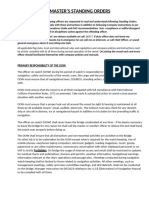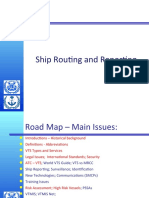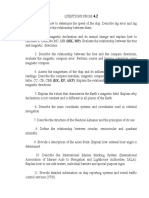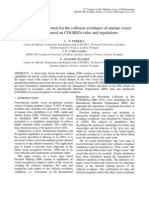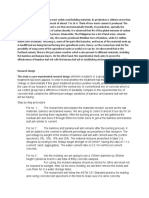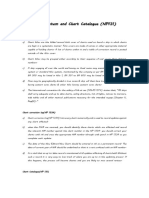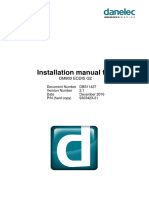100%(1)100% found this document useful (1 vote)
63 viewsTOPIC IMO Performance Standards ECDIS MSC 232 (
TOPIC IMO Performance Standards ECDIS MSC 232 (
Uploaded by
lorraine atienzaThe document summarizes the performance standards for Electronic Chart Display and Information Systems (ECDIS) set by the International Maritime Organization (IMO) resolution MSC 232 (82). The standards require that ECDIS equipment must be able to display navigational charts and information accurately and reliably to ensure safe navigation. It must also provide alerts in case of malfunctions, allow for easy chart updating, reduce the navigational workload, and meet display and accuracy requirements. The resolution also outlines standards for route monitoring, recording voyages, sensor input, testing malfunctions, backup arrangements, and power supply.
Copyright:
© All Rights Reserved
Available Formats
Download as PPTX, PDF, TXT or read online from Scribd
TOPIC IMO Performance Standards ECDIS MSC 232 (
TOPIC IMO Performance Standards ECDIS MSC 232 (
Uploaded by
lorraine atienza100%(1)100% found this document useful (1 vote)
63 views6 pagesThe document summarizes the performance standards for Electronic Chart Display and Information Systems (ECDIS) set by the International Maritime Organization (IMO) resolution MSC 232 (82). The standards require that ECDIS equipment must be able to display navigational charts and information accurately and reliably to ensure safe navigation. It must also provide alerts in case of malfunctions, allow for easy chart updating, reduce the navigational workload, and meet display and accuracy requirements. The resolution also outlines standards for route monitoring, recording voyages, sensor input, testing malfunctions, backup arrangements, and power supply.
Copyright
© © All Rights Reserved
Available Formats
PPTX, PDF, TXT or read online from Scribd
Share this document
Did you find this document useful?
Is this content inappropriate?
The document summarizes the performance standards for Electronic Chart Display and Information Systems (ECDIS) set by the International Maritime Organization (IMO) resolution MSC 232 (82). The standards require that ECDIS equipment must be able to display navigational charts and information accurately and reliably to ensure safe navigation. It must also provide alerts in case of malfunctions, allow for easy chart updating, reduce the navigational workload, and meet display and accuracy requirements. The resolution also outlines standards for route monitoring, recording voyages, sensor input, testing malfunctions, backup arrangements, and power supply.
Copyright:
© All Rights Reserved
Available Formats
Download as PPTX, PDF, TXT or read online from Scribd
Download as pptx, pdf, or txt
100%(1)100% found this document useful (1 vote)
63 views6 pagesTOPIC IMO Performance Standards ECDIS MSC 232 (
TOPIC IMO Performance Standards ECDIS MSC 232 (
Uploaded by
lorraine atienzaThe document summarizes the performance standards for Electronic Chart Display and Information Systems (ECDIS) set by the International Maritime Organization (IMO) resolution MSC 232 (82). The standards require that ECDIS equipment must be able to display navigational charts and information accurately and reliably to ensure safe navigation. It must also provide alerts in case of malfunctions, allow for easy chart updating, reduce the navigational workload, and meet display and accuracy requirements. The resolution also outlines standards for route monitoring, recording voyages, sensor input, testing malfunctions, backup arrangements, and power supply.
Copyright:
© All Rights Reserved
Available Formats
Download as PPTX, PDF, TXT or read online from Scribd
Download as pptx, pdf, or txt
You are on page 1of 6
TOPIC IMO Performance
Standards ECDIS MSC 232 (82)
Performance Standards IMO resolution
The ECDIS must meet the performance standards of the IMO
resolution (Maritime Safety Circular) MSC 232 (82) adopted on December
5, 2006. These standards highlight the following points:
The function of an ECDIS is primarily safe navigation and for the
purpose, it must be able to display all necessary information. This
information display must be approved by the authority of the
government or government-authorized hydrographic office. This
would mean that information display must comply with the
performance standards of the ECDIS and the display standards of
the International Hydrographic Organization (IHO) document
The ECDIS must enable charts to be updated in a simple and
reliable manner.
The charts in the ECDIS should be designed such that the
navigational workload of the seafarer is reduced.
The ECDIS should have the same reliability and presentation
capabilities of paper chart.
The ECDIS equipment should be capable of providing alerts in the
event of equipment malfunction or improper display information.
It should be able to distinguish between the ECDIS and the ENC,
explain the system electronic navigational chart (SENC).
The user should be able to select the preferred display among the
three display presentation modes available in the ECDIS, namely,
the standard display, base display, and all other information.
The requirements of the display of SENC information are
highlighted
The requirements related to the provision and updating of chart
information are highlighted.
There must be scale indicator.
There must be provisions in relation to the display of other
navigational information such as common reference system and
radar.
The requirements in relation to radar information must be
overlaid onto an ECDIS
The display modes required in an ECDIS
The use of standardized symbols and colors are recommended by
the IHO. (The symbols will vary depending on the scale of the
chart in use.) IHO S-52 standard).
The display requirements of an ECDIS display.
Requirements in relation to route monitoring and route planning.
Requirements in relation to voyage recording.\requirements in
relation to calculation accuracy (e.g. bearing and range
measurements)
Requirements in relation to sensor input (log, position fixing, etc.)
.
Requirements in relation to performance tests of malfunction
alarms, and indications.
Backup arrangements.
Thepower supply (the main ECDIS to be
connected to the main and emergency power
sources, while the backup ECDIS must have a
separate power source)
You might also like
- AbpDocument20 pagesAbpKo Sein Tan83% (12)
- Transa Ecdis-Vetting-Questionnaire PDFDocument11 pagesTransa Ecdis-Vetting-Questionnaire PDFB.m. Rifatur Rashid100% (9)
- Questionnaire With AnswerDocument5 pagesQuestionnaire With AnswerED Prado100% (1)
- List of Questions On Ecdis Asked by Vetting Inspectors and PSCDocument3 pagesList of Questions On Ecdis Asked by Vetting Inspectors and PSCsameer100% (9)
- ECDIS HandbookDocument13 pagesECDIS HandbookAndres Landa Figueroa100% (11)
- ECDIS - Lesson02Document6 pagesECDIS - Lesson02Zobaer Ahmed100% (1)
- Ecdis: Electronic Chart Display and Information SystemDocument63 pagesEcdis: Electronic Chart Display and Information SystemShah AlimNo ratings yet
- Electronic Chart Display and Information System (ECDIS) ECDIS IntroductionDocument57 pagesElectronic Chart Display and Information System (ECDIS) ECDIS Introductionroken100% (1)
- 5 False and Unwanted Radar ResponsesDocument20 pages5 False and Unwanted Radar ResponsesRoken Zgoul100% (1)
- Distance Speed TimeDocument2 pagesDistance Speed TimeUma Maheswararao100% (1)
- 3 1 Passage Planning AppraisalDocument11 pages3 1 Passage Planning Appraisalch100% (1)
- Demonstrate The Allocation, Assignment and Prioritization of ResourcesDocument4 pagesDemonstrate The Allocation, Assignment and Prioritization of ResourcesLone Mark KoKo Boiser100% (1)
- Recommendations On The Proactive Use of VDR Information (OCIMF, 2020 08)Document20 pagesRecommendations On The Proactive Use of VDR Information (OCIMF, 2020 08)LukeNo ratings yet
- Bridge ProceduresDocument10 pagesBridge ProceduresElton PintoNo ratings yet
- Comparison Between Arpa Radar and AisDocument8 pagesComparison Between Arpa Radar and AisHenrik LindqvistNo ratings yet
- Topic 1 Crowd Management InternationalDocument88 pagesTopic 1 Crowd Management Internationaljhonkerl.deguzman.edu.ph100% (1)
- Masters Standing Orders FINAL 21.07.23Document11 pagesMasters Standing Orders FINAL 21.07.23ujjwalmuskanNo ratings yet
- Manual BNWAS Iss02 Rev11 2012-01-10 New ATI & New PIRDocument62 pagesManual BNWAS Iss02 Rev11 2012-01-10 New ATI & New PIRJavier Fundora PaezNo ratings yet
- Nav-2 Finals Coverage: Traffic Lanes and Separation ZonesDocument17 pagesNav-2 Finals Coverage: Traffic Lanes and Separation ZonesElevado Elegene L.100% (2)
- Electronic Nav AidsDocument2 pagesElectronic Nav Aidssergiuserban100% (1)
- Ecdis Faqs-Wps OfficeDocument3 pagesEcdis Faqs-Wps OfficeRaven Jever100% (1)
- Traffic Separation Scheme RKK Modified 2017Document19 pagesTraffic Separation Scheme RKK Modified 2017Pandiya RajanNo ratings yet
- Lesson 2 Nav2Document2 pagesLesson 2 Nav2Mike James Bontuyan Alforque100% (1)
- ImdgintroDocument31 pagesImdgintroVitalie FricatelNo ratings yet
- Radar LimitationsDocument46 pagesRadar LimitationsTrazona Cabz100% (1)
- GPS and Navigation FinalDocument28 pagesGPS and Navigation FinalBalasi SimonaNo ratings yet
- Research MOR Sight ReductionDocument5 pagesResearch MOR Sight ReductionRJ DimacaliNo ratings yet
- SSBT HandoutDocument45 pagesSSBT HandoutLeo Keith JocsonNo ratings yet
- SSBT W BRM Day 2 Rev 000Document46 pagesSSBT W BRM Day 2 Rev 000Joseph Raluta100% (1)
- Nav 2 Reviewer AssessmentDocument16 pagesNav 2 Reviewer Assessmentryan armonioNo ratings yet
- NAV 224 PPT Semi Final Week 1 2Document60 pagesNAV 224 PPT Semi Final Week 1 2Jethro Lars UmbaoNo ratings yet
- 4 IsmDocument60 pages4 IsmPanagiwtis M.No ratings yet
- BANWASDocument5 pagesBANWASsureen123No ratings yet
- SELEX Galileo (Italy) - Jane's Air Traffic ControlDocument2 pagesSELEX Galileo (Italy) - Jane's Air Traffic Controlsaaz77No ratings yet
- Chapter 3 - Collision Avoidance: Relative MotionDocument88 pagesChapter 3 - Collision Avoidance: Relative Motionmouloud miloud100% (1)
- Dead Reckoning and PilotingDocument2 pagesDead Reckoning and Pilotingal_dulayNo ratings yet
- Gmdss Goc c1 FinalDocument154 pagesGmdss Goc c1 FinalmarcpadsNo ratings yet
- 2024 Quality Management System ManualDocument65 pages2024 Quality Management System ManualARC PHILS100% (1)
- Test ECDIS Course Notes QuizletDocument4 pagesTest ECDIS Course Notes QuizletHakan özNo ratings yet
- Jabatan Laut Malaysia: Bil Institusi Latihan Maritim Kursus-Kursus 1995 Manila 2010 Kursus Modular Sijil KecekapanDocument2 pagesJabatan Laut Malaysia: Bil Institusi Latihan Maritim Kursus-Kursus 1995 Manila 2010 Kursus Modular Sijil KecekapanMohammad Joynal AbedinNo ratings yet
- Lesson 1 Nav 1Document62 pagesLesson 1 Nav 1frenzvincentvillasis26100% (1)
- Nav 6Document13 pagesNav 6JohnNo ratings yet
- Sheet: Differential Global Positioning System (DGPS)Document2 pagesSheet: Differential Global Positioning System (DGPS)victorbarrabaja81No ratings yet
- Terminal Operating Guidelines For Ro Ro Break Bulk and Agricultural Bulk and Ro Ro Automotive TerminalsDocument73 pagesTerminal Operating Guidelines For Ro Ro Break Bulk and Agricultural Bulk and Ro Ro Automotive TerminalsNanda Win LwinNo ratings yet
- 5 Ship ReportingDocument27 pages5 Ship ReportingDicky Kusdy100% (1)
- Topic 1 Introduction of IamsarDocument32 pagesTopic 1 Introduction of IamsarjohannNo ratings yet
- Course Title: Meteorology For Navigation: Weather Services For ShippingDocument2 pagesCourse Title: Meteorology For Navigation: Weather Services For ShippingMehedi Hossain Mithil100% (1)
- Amplitude by CalculationDocument14 pagesAmplitude by Calculationatejoy12jesuscares100% (1)
- Nautinst 2019 PublicationsDocument16 pagesNautinst 2019 Publicationsdhaneshbhor100% (1)
- Solas V Reg19Document7 pagesSolas V Reg19ahmedNo ratings yet
- A857 PDFDocument26 pagesA857 PDFRafael RubioNo ratings yet
- Bnwas 2Document22 pagesBnwas 2gopuNo ratings yet
- 4 Msi Navarea Egc Safetynet Navtex)Document46 pages4 Msi Navarea Egc Safetynet Navtex)Salam Alecu100% (2)
- 2024 - General Procedure For Gmdss AssessmentDocument36 pages2024 - General Procedure For Gmdss AssessmentARC PHILS100% (1)
- Chapter 3 - Collision AvoidanceDocument96 pagesChapter 3 - Collision AvoidancekumarNo ratings yet
- QUESTIONS FROM 4.1 and 4.2 A.D. REVISED A.D.Document5 pagesQUESTIONS FROM 4.1 and 4.2 A.D. REVISED A.D.Oleksandr Plaksin100% (1)
- Vts PROCEDURESDocument26 pagesVts PROCEDURESAlexandro Vincente100% (1)
- Smart 10 EcdisDocument5 pagesSmart 10 EcdisAnamaria Daniela100% (1)
- Doppler LogDocument10 pagesDoppler Logiris2326100% (1)
- Navigational Instruments MSN 242Document10 pagesNavigational Instruments MSN 242bandar20% (1)
- Position Fixing WK 11Document28 pagesPosition Fixing WK 11Kalel Kasel100% (1)
- Decision Making System For The Collision Avoidance of Marine Vessel Navigation Based On COLREGs Rules and RegulationsDocument8 pagesDecision Making System For The Collision Avoidance of Marine Vessel Navigation Based On COLREGs Rules and RegulationsLP Perera100% (1)
- Distress Alert TransmitterDocument2 pagesDistress Alert TransmitterAjay SinghNo ratings yet
- DF0LV34 - Chartwork and TidesDocument11 pagesDF0LV34 - Chartwork and TidesEdvin Edw100% (2)
- The SatNav Users Guide to Navigation and Mapping Using GPSFrom EverandThe SatNav Users Guide to Navigation and Mapping Using GPSRating: 1 out of 5 stars1/5 (2)
- PC 5 Prelim PDFDocument227 pagesPC 5 Prelim PDFlorraine atienza0% (1)
- REVIEWERDocument9 pagesREVIEWERlorraine atienzaNo ratings yet
- Hint (PIA, I%, 5) 3.79 (PIF, I%, 5) 0.62Document11 pagesHint (PIA, I%, 5) 3.79 (PIF, I%, 5) 0.62lorraine atienzaNo ratings yet
- Contracts and SpecificationDocument30 pagesContracts and Specificationlorraine atienza100% (1)
- Planning Scheduling Pert CPMDocument34 pagesPlanning Scheduling Pert CPMlorraine atienzaNo ratings yet
- 2019 MSTE MayDocument11 pages2019 MSTE Maylorraine atienzaNo ratings yet
- Module 2 PDFDocument10 pagesModule 2 PDFlorraine atienzaNo ratings yet
- Activity 1Document2 pagesActivity 1lorraine atienzaNo ratings yet
- 30m High Communication Steel PoleDocument19 pages30m High Communication Steel Polelorraine atienzaNo ratings yet
- Module 4 (Gr. 4)Document26 pagesModule 4 (Gr. 4)lorraine atienzaNo ratings yet
- Module 4Document8 pagesModule 4lorraine atienzaNo ratings yet
- UntitledDocument26 pagesUntitledlorraine atienzaNo ratings yet
- QUIZDocument12 pagesQUIZlorraine atienzaNo ratings yet
- Concrete Is Listed As One of The Most Widely Used Building MaterialsDocument2 pagesConcrete Is Listed As One of The Most Widely Used Building Materialslorraine atienzaNo ratings yet
- Maritime CommunicationsDocument25 pagesMaritime Communicationslorraine atienzaNo ratings yet
- Exercise #11 Flow Over WeirsDocument1 pageExercise #11 Flow Over Weirslorraine atienzaNo ratings yet
- Case 1: Ce Laws, Contracts and Ethics Finals - Exercise 1Document8 pagesCase 1: Ce Laws, Contracts and Ethics Finals - Exercise 1lorraine atienzaNo ratings yet
- Principles of Steel Design (Lab #1)Document4 pagesPrinciples of Steel Design (Lab #1)lorraine atienzaNo ratings yet
- Ship Safety Equipment ReportDocument13 pagesShip Safety Equipment Reportitavsa100% (1)
- ECDIS For BeginnersDocument32 pagesECDIS For BeginnersNoel Domingo100% (3)
- Arpa Radar - Vision Master - Arpa Radarchart Radar - Ship's Manual Volume 1 (Installation, Servicing & Maintenance) PDFDocument568 pagesArpa Radar - Vision Master - Arpa Radarchart Radar - Ship's Manual Volume 1 (Installation, Servicing & Maintenance) PDFCarlos Eduardo Galvão100% (1)
- Issue 22 AccidentsDocument12 pagesIssue 22 AccidentsDenis HranjNo ratings yet
- BA Quick ReferenceDocument1 pageBA Quick ReferenceVikrant TomarNo ratings yet
- Global Maritime Training Centre (GMTC) : Training Is Not An Expense, It Is An InvestmentDocument22 pagesGlobal Maritime Training Centre (GMTC) : Training Is Not An Expense, It Is An InvestmentDavid Nazareth100% (2)
- Ukp Hari - IiiDocument40 pagesUkp Hari - IiiIlham pratama SaputraNo ratings yet
- 01wknm13 Week01 2013 PDFDocument99 pages01wknm13 Week01 2013 PDFShaneVaz100% (1)
- Na/'Igating: Integrated Electronic ChartDocument22 pagesNa/'Igating: Integrated Electronic ChartDrago DragicNo ratings yet
- Fea 2807Document620 pagesFea 2807srinu1984No ratings yet
- Chart CorrectionsDocument7 pagesChart CorrectionsShubham Kumar100% (2)
- Checking The IHO S-52 Presentation Library Edition Number in The ECDISDocument4 pagesChecking The IHO S-52 Presentation Library Edition Number in The ECDISVisveswaran InbasekaranNo ratings yet
- Ecdis Handbook 2Document1 pageEcdis Handbook 2Santoso Wahyudi100% (1)
- Chart No 1Document134 pagesChart No 1Seth Coan100% (1)
- Changes RegulationDocument27 pagesChanges RegulationredzwanNo ratings yet
- TECDIS User Guide 1 - 00 PDFDocument40 pagesTECDIS User Guide 1 - 00 PDFChristyle Guzman100% (2)
- Furuno: 1 Panel Computer UnitDocument3 pagesFuruno: 1 Panel Computer UnitAnonymous QRJuPTg2No ratings yet
- MGN 194 - EcdisDocument32 pagesMGN 194 - Ecdisaakash9090No ratings yet
- MGN 610 (M+F)Document45 pagesMGN 610 (M+F)Rob GaffneyNo ratings yet
- Installation Manual For: Dm800 Ecdis G2Document67 pagesInstallation Manual For: Dm800 Ecdis G2akhilNo ratings yet
- 20 Common Questions On ECDIS eGLOVE G2Document3 pages20 Common Questions On ECDIS eGLOVE G2JAGJIT SINGHNo ratings yet
- ECDIS 10 Questions From SIRE InspectorDocument21 pagesECDIS 10 Questions From SIRE InspectorFlexi100% (3)
- IMU CRB Part-1Document25 pagesIMU CRB Part-1Fahd AkramNo ratings yet
- Procedures For Chart, Publication and ENC CorrectionsDocument10 pagesProcedures For Chart, Publication and ENC CorrectionsPreeti Doddamani100% (2)
- IHO S-52 Specifications For Chart Content and Display Aspects of ECDISDocument92 pagesIHO S-52 Specifications For Chart Content and Display Aspects of ECDIScatalinNo ratings yet
















